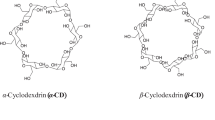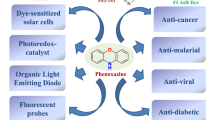Abstract
Two new fluorophores, 6,7-dimethoxy-9-methyl-2,3,4,9-tetrahydro-1H-carbazol-1-one (DMTCO) and 5-methyl-8,9-dihydro-5H-[1,3]dioxolo[4,5-b]carbazol-6(7H)-one (MDDCO), first of their kind, have been synthesized from the corresponding methoxy and methylenedioxy derivatives of 2,3,4,9-tetrahydro-1H-carbazol-1-one respectively. Comprehensive photophysical characterization of these compounds has been carried out in sixteen different homogeneous solvents and binary solvent mixtures. Both of these compounds are sensitive to solvent polarity, but the sensitivity is much higher in electronic excited state observed by steady-state and time-resolved fluorescence experiments than in ground state studied by UV–vis absorption spectroscopy. The fluorescence spectral shifts are linearly correlated with the empirical parameters of the protic solvents and also the quantitative influence of the empirical solvent parameters on the emission maxima of the compounds has been calculated. The change in dipole moment of the compounds in their excited state has been calculated from the shifts in corresponding emission maxima in pure solvents. A higher dipole moment change of both DMTCO and MDDCO in protic solvents is due to intermolecular hydrogen bonding which is further confirmed by the comparison of their behaviour in toluene-acetonitrile and toluene-methanol solvent mixtures. From structural features, MDDCO is more planar compared to DMTCO, which is reflected better in fluorescence quenching of the former with organic bases, N,N-dimethylaniline and N,N-diethylaniline. Laser flash photolysis experiments prove that the quenching interaction originates from photoinduced electron transfer from the bases to the compounds.



























Similar content being viewed by others
References
Lakowicz JR (2006) Principles of Fluorescence Spectroscopy. Springer, New York
Ranjith C, Vijayan KK, Praveen VK, Kumar NSS (2010) Photophysical investigation of 3-substituted 4-alkyl and/or 7-acetoxy coumarin derivatives—A study of the effect of substituents on fluorescence. Spectrochim Acta Part A 75:1610–1616
Pişkin M, Durmuş M, Bulut M (2012) Synthesis and investigation on photophysical and photochemical properties of 7-oxy-3-methyl-4-phenylcoumarin bearing zinc phthalocyanines. Spectrochim Acta Part A 97:502–511
Gaber M, El-Daly SA, Fayed TA, El-Sayed YS (2008) Photophysical properties, laser activity and photoreactivity of a heteroaryl chalcone: a model of solvatochromic fluorophore. Opt Las Tech 40:528–537
Bojinov VB, Panova IP, Grabchev IK (2007) Novel polymerizable light emitting dyes – combination of a hindered amine with a 9-phenylxanthene fluorophore. Synthesis and photophysical investigations. Dye Pigm 74:187–194
Feng J, Chen X, Han Q, Wang H, Lu P, Wang Y (2011) Naphthalene-based fluorophores: Synthesis characterization, and photophysical properties. J Lumin 131:2775–2783
Wang ZW, Cao QY, Lin S, Zhuo L, Li ZH (2013) 2,6-Diphenylpyridine-based fluorophores: Synthesis, photophysical properties and effects of protonation. J Photochem Photobiol A 251:106–112
Saito Y, Shinohara Y, Ishioroshi S, Suzuki A, Tanaka M, Saito I (2011) Synthesis of environmentally sensitive 2′-deoxyguanosine containing solvatochromic pyrene fluorophore. Tet Lett 52:2359–2361
Bag SS, Pradhan MK, Kundu R, Jana S (2013) Highly solvatochromic fluorescent naphthalimides: Design, synthesis, photophysical properties and fluorescence switch-on sensing of ct-DNA. BioMed Chem Lett 23:96–101
Ooyama HE, Ooyama Y, Hino T, Sakamoto T, Yamaguchi T, Yoshida K (2011) Synthesis and photophysical properties of structural isomers of novel 2,10-disubstituted benzofuro[2,3-e] naphthoxazole-type fluorescent dyes. Dye Pigm 91:481–488
Firmino ADG, Gonçalves MST (2012) Bifunctionalised long-wavelength fluorescent probes for biological applications. Tet Lett 53:4946–4950
Li Y, Scudiero L, Ren T, Dong WJ (2012) Synthesis and characterizations of benzothiadiazole-based fluorophores as potential wavelength-shifting materials. J Photochem Photobiol A 231:51–59
Dey D, Bose A, Bhattacharyya D, Basu S, Maity SS, Ghosh S (2007) Dibenzo[a, c]phenazine: A Polarity-Insensitive Hydrogen-Bonding Probe. J Phys Chem A 111:10500–10506
Knölker HJ, Reddy KR (2002) Isolation and synthesis of biologically active carbazole alkaloids. Chem Rev 102:4303–4428
Schmidt AW, Reddy KR, Knölker HJ (2012) Occurrence, biogenesis, and synthesis of biologically active carbazole alkaloids. Chem Rev 112:3193–3328
Mitra AK, Ghosh S, Chakraborty S, Sarangi MK, Saha C, Basu S (2012) Photophysical properties of an environment sensitive fluorophore 1-keto-6,7-dimethoxy-1,2,3,4-tetrahydrocarbazole and its excited state interaction with N, N-dimethylaniline: A spectroscopic investigation. J Photochem Photobiol A 240:66–74
Chakraborty S, Chattopadhyay G, Saha C (2011) Montmorillonite-KSF induced Fischer indole cyclization under microwave towards a facile entry to 1-keto-1,2,3,4-tetrahydrocarbazoles. Ind J Chem B 50:201–206
Mitra AK, Ghosh S, Chakraborty S, Basu S, Saha C Synthesis and Spectroscopic Exploration of Carboxylic Acid Derivatives of 6-Hydroxy-1-Keto-1,2,3,4-tetrahydrocarbazole: Hydrogen Bond Sensitive Fluorescent Probes. J Lumin accepted
Kawski A, Bojarski P, Kuklinski B (2008) Estimation of ground-and excited-state dipole moments of Nile red dye from solvatochromic effect on absorption and fluorescence spectra. Chem Phys Lett 463:410–412
Lippert E (1957) Spektroskopische bestimmung des dipolmomentes aromatischer Verbindungen im ersten angeregten singulettzustand. Ber Bunsenges Phys Chem 61:962–975
Mataga N, Kaifu Y, Koizumi M (1956) Solvent effects upon fluorescence spectra and the dipolemoments of excited molecules. Bull Chem Soc Jpn 29:465–470
Kamlet MJ, Abboud JLM, Abraham MH, Taft RW (1983) Linear solvation energy relationships. 23. A comprehensive collection of the solvatochromic parameters, pi.*, alpha., and.beta., and some methods for simplifying the generalized solvatochromic equation. J Org Chem 48:2877–2887
Abraham MH, Grellier PL, Abboud JLM, Doherty RM, Taft RW, Doherty M (1988) Solvent effects in organic chemistry — recent developments. Can J Chem 66:2673–2686
Kamlet MJ, Abboud JLM, Taft RW (1977) The solvatochromic comparison method. 6. The.pi.* scale of solvent polarities. J Am Chem Soc 99:6027–6038
Kamlet MJ, Taft RW (1976) The solvatochromic comparison method. I. The.beta.-scale of solvent hydrogen-bond acceptor (HBA) basicities. J Am Chem Soc 98:377–383
Taft RW, Abboud JLM, Kamlet MJ (1981) Solvatochromic comparison method. 20. Linear solvation energy relationships. 12. The d.delta. term in the solvatochromic equations. J Am Chem Soc 103:1080–1086
Taft RW, Kamlet MJ (1976) The solvatochromic comparison method. 2. The.alpha.-scale of solvent hydrogen-bond donor (HBD) acidities. J Am Chem Soc 98:2886–2894
Kamlet MJ, Dickinson C, Taft RW (1981) Linear solvation energy relationships Solvent effects on some fluorescence probes. Chem Phys Lett 77:69–72
Critchfield FE, Gibson JA, Hall JL (1953) Dielectric constant for the dioxane—water system from 20 to 35°. J Am Chem Soc 75:1991–1992
Geddes JA (1933) The fluidity of dioxane - water mixtures. J Am Chem Soc 55:4832–4837
Stallard RD, Amis ES (1952) Heat of vaporization and other properties of dioxane, water and their mixtures. J Am Chem Soc 74:1781–1790
Kosower EM, Dodiuk H, Tanizawa K, Ottolenghi M, Orbach N (1975) Intramolecular donor - acceptor systems. Radiative and nonradiative processes for the excited states of 2-N-arylamino-6-naphthalenesulfonates. J Am Chem Soc 97:2167–2178
Reynolds L, Gardecki JA, Frankland SJV, Horng ML, Maroncelli M (1996) Dipole Solvation in nondipolar solvents: experimental studies of reorganization energies and solvation dynamics. J Phys Chem 100:10337–10354
Suppan P (1990) Invited review solvatochromic shifts: the influence of the medium on the energy of electronic states. J Photochem Photobiol A 50:293–330
Kro´licki R, Jarzeba W, Mostafavi M, Lampre I (2002) J Phys Chem A 106:1708–1713
Tang R, Zhang P, Lia H, Liu Y, Wang W (2011) Photosensitized xanthone-based oxidation of guanine and its repair: a laser flash photolysis study. J Photochem Photobiol B 105:157–161
Li K, Wang H, Cheng L, Wang M, Zhua R, Wang SL (2011) Characterization of transient species produced from laser flash photolysis of a new cardioprotective drug: S-propargyl-cysteine. J Photochem Photobiol B 219:195–199
Rigoli IC, Bonilha JBS, Quina FH, Okano LT, Naal RMZG (2011) Photoreactions of n-alkyl-3-nitrophenyl ethers with aromatic amines in SDS micelles: a laser flash photolysis study. J Photochem Photobiol A 222:34–39
Sarangi MK, Basu S (2011) Associated electron and proton transfer between Acridine and Triethylamine in AOT reverse micelles probed by laser flash photolysis with magnetic field. Chem Phys Lett 506:205–210
Wang JT, Sun Q, Zhang LM, Yu SQ (2010) Solvent effects of photoinduced electron transfer reactions of triplet fluorenone with amines. Chin Sci Bull 55:2891–2895
Acknowledgements
We are thankful to Council of Scientific and Industrial Research (CSIR), New Delhi, India for providing research fellowships to two of the authors [Amrit Krishna Mitra: SRF, File No. 09/951(0003)/2009-EMR-I and Sujay Ghosh: SRF, File No. 09/489(0064)/2009-EMR-I]. This work has been funded by CBAUNP, MMDDA, BARD projects of SINP and DAE, CSIR projects of the Govt. of India. We are also thankful to Prof. Krishnangshu Roy, Director, School of Tropical Medicine, Kolkata and Prof. Milan Kumar Sanyal, Director, Saha Institute of Nuclear Physics, Kolkata for their interest in the work.
Author information
Authors and Affiliations
Corresponding author
Additional information
Sujay Ghosh and Amrit Krishna Mitra are Equal Contributors.
Rights and permissions
About this article
Cite this article
Ghosh, S., Mitra, A.K., Saha, C. et al. Tuning the Solution Phase Photophysics of Two De Novo Designed Hydrogen Bond Sensitive 9-methyl-2,3,4,9-tetrahydro-1H-carbazol-1-one Derivatives. J Fluoresc 23, 1179–1195 (2013). https://doi.org/10.1007/s10895-013-1249-z
Received:
Accepted:
Published:
Issue Date:
DOI: https://doi.org/10.1007/s10895-013-1249-z




